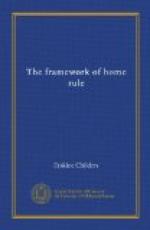With this explanatory digression about a very important feature of Anglo-Irish finance, I return to the findings of the Royal Commission of 1894-1896. The figures supplied to them were as shown on the opposite page.
It will be noticed that the average “true” revenue of Ireland was stationary at a little over five millions from 1820 to 1850, rose with a bound to seven and a half millions with the equalization of taxes in the decade 1850-1860, and remained stationary at that figure for the remaining thirty-four years. Expenditure in Ireland quadrupled in the whole sixty-four years; and the net contribution to Imperial services, after rising from three and a half millions (in round numbers) in 1820 to five and a half millions in 1860, fell automatically, as the expenditure rose, and had stood at two millions from 1890 afterwards. Population had fallen by two millions, but the “true” revenue raised per head of population rose from 15s. 5d. in 1819 to L1 13s. 5d. in 1894, while the local expenditure rose from 4s. 7d. per head in 1820 to L1 5s. in 1894.
STATEMENT SHOWING THE ESTIMATED LOCAL EXPENDITURE INCURRED IN IRELAND, AND THE BALANCE OF TRUE REVENUE WHICH IS AVAILABLE FOR IMPERIAL SERVICES AFTER SUCH EXPENDITURE HAS BEEN MET:
Revenue as Adjustment Estimated
Estimated Balance Population
Collected (+) or (-) True Local
available
Revenue Expenditures
for
Imperial
Services
Decadal figures. L L
L L L -------------------------------
-------------------------------------------------
1819-20 5,253,909 + 2,655 5,256,564 1,564,880
3,691,684 6,801,000 1829-30 4,161,217 +1,040,908
5,502,125 1,345,579 4,156,576 7,767,401 1839-40
4,571,150 + 841,739 5,412,889 1,789,567 3,626,322
8,175,124 1849-50 4,338,091 + 523,374 4,861,465
2,247,687 2,613,778 6,574,278 1859-60 7,097,994
+ 602,430 7,700,334 2,304,334 5,396,000 5,798,967
1869-70 7,331,058 + 95,274 7,426,332 2,938,122
4,488,210 5,412,377 1879-80 7,831,316 —
550,520 7,280,856 4,054,549 3,226,307 5,174,836
1889-90 9,005,932 -1,271,254 7,734,678 5,057,708
2,676,970 4,704,750




